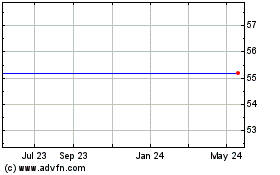Standard & Poor's Reviews Float Adjustment of U.S. Indices
October 27 2003 - 5:50PM
PR Newswire (US)
Standard & Poor's Reviews Float Adjustment of U.S. Indices
Releases Concept Paper and Calls for Rethinking of Paradigm NEW
YORK, Oct. 27 /PRNewswire/ -- Standard & Poor's, the leading
provider of independent investment research, indices and ratings,
announced today that it is reviewing the idea of introducing float
adjustments to its U.S. indices, including the S&P 500. As part
of this review, a concept paper examining the implications of float
adjustment of U.S. indices was released on Standard & Poor's
web site. Float adjustment refers to the reduction of a company's
weight in an index to exclude closely held shares, certain legal
restrictions on investments and cross-holdings. Float adjustment
was initially done in emerging market indices to make them more
liquid and investable. In recent years, many other indices have
also been float-adjusted. However, there has not yet been a
comprehensive review of float adjustment, and particularly of float
adjustment in the U.S. "This is the first comprehensive examination
of the practical and conceptual implications of float adjustment on
indices," said David Blitzer, managing director and chairman of the
S&P Index Committee. "The study shows that float adjustment
would have little impact on the structure or risk profile of
Standard & Poor's U.S. indices." Examining the three different
types of float adjustment, the paper finds that investment
regulations are not an issue for U.S. equities and that adjustment
for cross holdings prevents double counting and is conceptually
justified. However, adjustment for strategic holdings is not
consistent with the conceptual purpose of indices. The paper also
finds that float adjustment would not improve liquidity of the
index portfolio because of incorporation of minimum liquidity and
public float criteria in current S&P U.S. index methodology.
Many of Standard & Poor's non-U.S. indices are currently
float-adjusted, reflecting market conditions outside the U.S. The
study presents evidence of public float and liquidity in U.S.
markets as being much higher than in non-U.S. markets. Also, in
many non-U.S. markets, there exist regulations on investment
restrictions and stock holdings of government or quasi-government
entities. The S&P Index Committee will be consulting market
participants and its U.S. Index Advisory Panel on this issue. The
review and any changes resulting from it would affect Standard
& Poor's U.S. indices only. The full concept paper can be found
at http://www.standardandpoors.com/indices. About Standard &
Poor's Standard & Poor's, a division of The McGraw-Hill
Companies (NYSE:MHP), is the world's foremost provider of
independent credit ratings, indices, risk evaluation, investment
research, data and valuations. With 5000 employees located in 20
countries, Standard & Poor's is an essential part of the
world's financial infrastructure and has played a leading role for
more than 140 years in providing investors with the independent
benchmarks they need to feel more confident about their investment
and financial decisions. For more information, visit
http://www.standardandpoors.com/. DATASOURCE: Standard & Poor's
CONTACT: Media: Lynn Cohn Standard & Poor's 212 438 1650 David
M. Blitzer Chairman of the S&P Index Committee Web site:
http://www.standardandpoors.com/
Copyright
Mcgraw Hill (NYSE:MHP)
Historical Stock Chart
From Jun 2024 to Jul 2024

Mcgraw Hill (NYSE:MHP)
Historical Stock Chart
From Jul 2023 to Jul 2024
